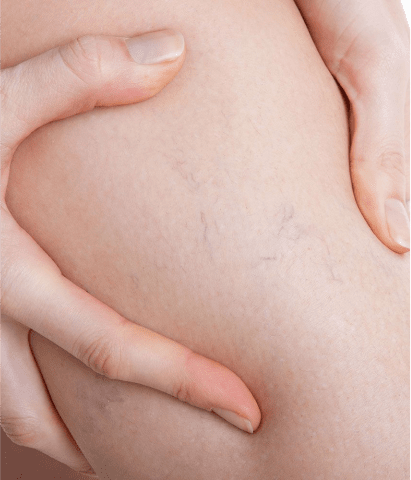Overview
Thread veins, also known as spider veins, are tiny prominent veins that lie just beneath the surface of the skin. Their distinctive branching pattern resembles a spider’s web, hence the name. Although spider veins can appear anywhere on the body, they are most frequently found on the legs and face.
Thread veins are an incredibly common problem, affecting around 80% of all adults at some point in their lives. Thankfully, thread veins can typically be treated effectively through straightforward and routine procedures.
Thread Vein Symptoms
Although thread veins don’t often cause symptoms, they can be unsightly. People usually come to us seeking treatment to improve the cosmetic appearance. Some people can experience symptoms such as burning, cramp and itching, but these symptoms are more commonly associated with varicose veins.
The appearance of thread veins on the skin is influenced by a number of different factors. These include the size of the vein, the flow of blood within the vein and the proximity of the vein to the skin surface. Threads can vary in colour, usually appearing pink or red. They can also look darker when they’re larger, most commonly blue or purple.
The depth of colour is also influenced by how deep the vein is relative to the skin’s surface. Veins closer to the surface will be more vivid, while deeper veins will have a less distinct appearance.
It’s worth noting that thread veins can sometimes appear as single short, straight veins, as opposed to the typical “spider’s web” pattern.
Thread Vein Causes
The cause of thread veins is often unknown. Like with varicose veins, there’s a genetic predisposition to the condition. We’ve witnessed patterns among families, including from parents to children and between siblings. Other risk factors for thread veins include pregnancy, topical steroid use, oestrogen treatment, prolonged standing and local trauma to the skin1.
Occasionally, thread veins of the legs may be an indication of an underlying venous condition.

We are processing your answers – hold tight!
Complete Quick Online Assessment
Thread Vein Diagnosis
As they’re largely cosmetic, it’s possible to diagnose thread veins through a visual examination of the affected area. However, it’s not possible to establish the cause of the thread veins like this.
To rule out an underlying venous disease, all of our patients presenting with thread veins of the legs undergo duplex ultrasound at initial consultation. Failure to recognise and treat underlying venous disease may cause treatment failure or early thread vein recurrence.
Thread Vein Prevention
Thread veins are very common, especially with advancing age. While there’s no definite way to prevent the appearance of thread veins, maintaining a healthy weight and exercising regularly can help improve circulation to the legs.
If you have a job where you predominantly sit down, you should try to move around or stretch your legs periodically to ensure optimal blood flow and circulation. If you have symptoms such as burning, cramps or itching, wearing compression stockings may be beneficial. Smoking and excessive alcohol consumption have also been linked to the appearance of thread veins on the face.
Treatment
Thread veins on the surface of the legs can be treated effectively using a procedure called microsclerotherapy. We’ve been using this technique since 2003 with great results. It’s a minimally invasive, walk in, walk out procedure.
Thread veins on the face are best treated using a procedure called thermocoagulation.
Reference
- Schwartz L, Maxwell H. Sclerotherapy for lower limb telangiectasias. Cochrane Database of Systematic Reviews 2011, Issue 12. Art. No.: CD008826. DOI: 10.1002/14651858.CD008826.pub2. Accessed 27 August 2021.
Find your nearest VeinCentre clinic today
With over 40 clinics nationwide, you don’t have to walk far to walk out happy.
